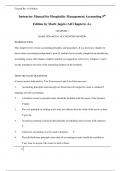Exam (elaborations)
Instructor Manual for Hospitality Management Accounting 9th Edition by Marti Jagels (All Chapters) A+
- Course
- Institution
- Book
Instructor Manual for Hospitality Management Accounting 9th Edition by Marti Jagels (All Chapters) A+ ..
[Show more]



